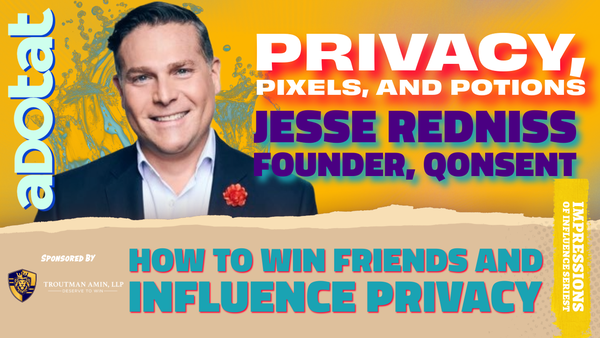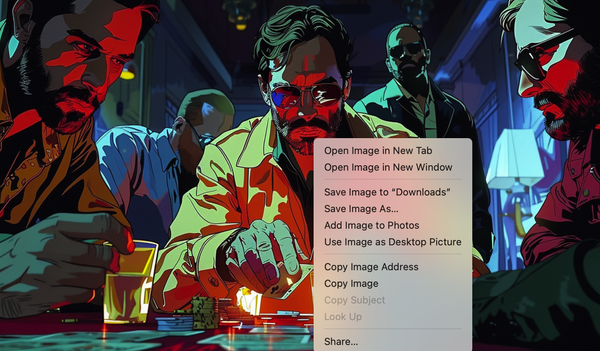Why Your Programmatic Strategy Sucks Without Curation (And How to Fix It)
I’m Pesach Lattin, and if you’re not familiar with me, you probably haven’t been paying attention to the ad tech world. I’ve been in this racket since the internet was powered by hamster wheels. I launched FGN.com back in ’96, sold it to Cybereerps for just under half a mil, and that was my jumping-off point. From there, I rolled out networks like Total Women and Total Health, all about curated content and sites. Fast
forward to now, and the ad tech scene is in desperate need of a shake-up. Enter the curated marketplace, which is basically the reincarnation of those old-school niche ad networks, but with a slick, high-tech vibe. Programmatic advertising has turned into a monster, an over-engineered mess where everyone’s fighting over scraps. The impending cookie apocalypse has thrown the industry into a tailspin, with folks scrambling to figure out identity resolution,
targeting, and attribution. But here’s the kicker: the solution isn’t some shiny new tech—it’s something as old as the internet itself: curation. Think of curation as that cool DJ who knows exactly what tracks to drop to get everyone moving. In the programmatic world, curation is about handpicking the best data and supply, packaging it up into unique PMP-based deals, and selling it through any DSP. It’s quick, efficient, and fits right into the existing
programmatic workflow without breaking a sweat. For agencies, curation is a lifeline. Remember when agencies were chosen for their media buying prowess, optimization skills, and cozy publisher connections? Then programmatic came along and flattened everything into a bland, automated soup. But with curation, agencies can reclaim their mojo. They can centralize their campaigns, making sure every dollar is tracked and maximized. No more black box nonsense—curation
brings transparency, letting agencies see exactly where their money is going and how it’s being spent. This newfound clarity also means agencies can rebuild those direct relationships with media owners, cutting deals based on volume and aligned brand values, just like the good old days. Data providers, those unsung heroes, have always been stuck in a thankless role. They’re like the middle children of programmatic, always overlooked and underappreciated. They face
issues like lack of reporting visibility, difficulty reaching media buyers, and safeguarding data. But curation offers them a way out. By packaging their data with media on the supply side, data providers gain control over their segments and can track usage in real-time. This not only improves revenue forecasting but also protects their proprietary data. And with third-party cookies on the way out, curation allows data providers to leverage the best identity resolution solutions, keeping them
relevant and in control. Publishers, on the other hand, have their own set of challenges. Their first-party data is like gold, especially with third-party cookies disappearing. But to let advertisers target their audiences off-network, they’ve had to give up some control over this valuable data. Curation changes that. By integrating their first-party data into curated deals, publishers can protect their assets while extending their audience reach. They can target
their own visitors on the open web without having to run an in-house trade desk, which is often expensive and resource-intensive. Curation offers publishers a streamlined way to monetize their audiences with minimal friction, using the same programmatic workflows that are already in place. It’s like getting the best of both worlds—control and monetization—without the usual headaches. To put it bluntly, curation is turning the tables on the programmatic ecosystem.
Agencies are finding new ways to stand out, data providers are gaining the control they’ve always wanted, and publishers are finally able to fully leverage their first-party data without losing their grip on it. This isn’t just a subtle shift; it’s a revolution that’s putting power back into the hands of those who create and manage content. Drew Stein of Audigent is all in on curation, calling it a simple yet transformative approach. The old way was all about the
buy side, using DSP platforms to optimize data and inventory. Curation flips that script, pushing data through the supply path and opening up new opportunities for targeting and optimization. It’s a future-proof strategy that marries data with the sell side, creating better results for brands and media agencies. And let’s not forget the economic and regulatory landscape. With privacy laws tightening and the end of third-party cookies looming, advertisers are
scrambling to find new ways to engage consumers. PubMatic, for instance, is working with top advertisers on sell-side data activation to build resilient, channel-agnostic strategies. Sell-side targeting is emerging as a privacy-safe tactic that helps brands navigate these changes while maintaining high performance and visibility. So, where does this leave us? It brings us full circle to the concept of the curated marketplace. Back in the day, niche ad networks like
the ones I created thrived on curated content and targeted audiences. Today’s curated marketplaces are the sophisticated descendants of those early networks, leveraging advanced technology to deliver highly targeted, effective advertising solutions. They bring transparency, control, and efficiency back to the table, addressing the shortcomings of a fragmented and often opaque programmatic landscape. The rise of Curation Houses like Kargo, Concert by Vox, Audigent,
and Multilocal is a testament to this shift. These modern intermediaries are campaign-oriented, driving demand directly from clients and media agencies. They’re equipped with advanced data targeting features and are poised to take over the decision-making layer that DSPs once dominated. Publishers, wary of data leakage and rising costs, are more than willing to collaborate with these curators in hopes of unlocking new revenue streams. In essence, the curated
marketplace is reshaping the programmatic world, offering a sophisticated, data-driven approach that benefits everyone involved. It’s a reminder that sometimes, looking back can help us move forward, bringing timeless strategies into the modern era with a fresh, innovative twist.
Oh joy, another ad tech carnival. But you asked for it, so here we go: a special for our newsletter on how the curated marketplace actually works. Buckle up, buttercup. First up, we have Agencies, Brands, and Buyers, the holy trinity of marketing desperation. These folks are scrounging for premium inventory like it's the last slice of pizza at a college party. They’re not just snapping up
whatever’s left in the ad junkyard. Nope, they’re negotiating Private Marketplace (PMP) deals, thinking they’re Wall Street hotshots. The SSPs (Supply-Side Platforms) are the middlemen, making sure these ad slots are shiny enough to catch their fancy. Now, the SSPs aren’t doing this solo. They've got a motley crew of Signal Vendors, Ad Networks, and Curation Sales Houses. Signal Vendors are your data wizards, brewing up the secret sauce that makes these ads
irresistible. Ad Networks? They’re the socialites, networking like their lives depend on it. And the Curation Sales Houses? Think of them as the used car salesmen of the ad world, convincing the brands that this curated inventory is the unicorn they’ve been chasing. Then there’s the unsung heroes: Standalone Curation Services, offering "Curation as a Service" (CaaS). Yes, everything's as-a-service these days—get over it. Their job? Take the chaotic mess of PMPs and
turn it into a well-oiled machine. Scaling these PMPs is a circus act: spinning plates, juggling flaming torches, and walking a tightrope all at once. But hey, somebody’s gotta do it, and these folks are the best in the biz. Now, let’s talk about the technical nitty-gritty: the Activation Layer. Here, Signal Vendors return, armed with data galore. They power the whole shebang, while Curation Marketplaces act like the eBay of ad curation—buyers and sellers haggling
for the best deals. Finally, this curated gold gets integrated with DSPs (Demand-Side Platforms), ensuring every precious ad dollar is milked dry. And the future? It’s a jungle out there. The death of third-party cookies has everyone in a tizzy. Adaptation is the new black, with SPA frameworks and DSPs muscling into the curation game. Competition is fierce, costs are skyrocketing, and only the smartest will survive. Master the art of curation, and you’ll ride the ad tech roller coaster to glory. Or crash spectacularly. Either way, it’ll be a wild ride.
|
THREE STORIES THAT YOU NEED TO KNOW in a format that isn't TL:DR summarized for the busy executive
The Kids Online Safety Act is turning into the digital age's Pandora's box, with civil liberties groups sounding the alarm over its potential for censorship and privacy violations. Despite the bill's noble aim to protect kids from the dark side of
social media, critics fear it could muzzle marginalized voices and politically sensitive content. Major players like the ACLU and the Electronic Frontier Foundation argue that the current draft could force tech platforms to play morality police, censoring lawful yet controversial topics like sexual health, racial justice, and LGBTQ+ issues. Senator Ron Wyden’s proposed tweaks, emphasizing user privacy and content neutrality, might just be the lifeline this bill needs to avoid becoming an
overzealous nanny state mandate. Meanwhile, parents are caught in the crossfire, with concerns about overly broad surveillance tools potentially turning them into unwitting Big Brother figures in their children's online lives.
In a plot twist worthy of a Silicon Valley drama, TrustX is breaking free from its parent group Digital
Content Next (DCN) and hitching its wagon to a new venture-backed juggernaut, Symitri Inc. This move aims to revolutionize the post-cookie digital ad marketplace with a privacy-compliant, high-speed data-processing tech stack. TrustX's supply-side platform (SSP) will stay nonprofit, while Symitri, backed by ad tech bigwigs like Jonah Goodhart and Akamai, will push the envelope with real-time data cleanrooms. Imagine secure, privacy-friendly ad trading that can finally keep up with the
frantic pace of real-time bidding—retargeting and all. David Kohl, transitioning from TrustX's CEO to Symitri's, envisions a platform where even the smallest advertisers can seamlessly retarget their loyalty card holders without the data security nightmares. As Symitri gears up for its beta launch this summer, it promises to be the cutting-edge solution that premium publishers and advertisers have been craving in a privacy-obsessed world.
Dentsu's Q1
revenue report reads like a rollercoaster, with a global organic revenue drop of 3.7%—but they're still banking on a 1% growth for the year. The launch of their new brand platform, "Innovating to Impact," promises to leverage their strengths in creativity, media, data, and tech to drive this rebound. Japan shone with a 2.4% growth, but the Americas, EMEA, and APAC (excluding Japan) all saw declines. Dentsu's strategy? Double down on their One Dentsu model, aiming for seamless
integration across their capabilities. With big wins like Apple+ TV and T-Mobile, they're poised for a comeback once economic headwinds settle. CEO Hiroshi Igarashi’s optimistic that their holistic approach will transform client businesses, despite the early-year turbulence.
You're looking for an edge in your online marketing. ADOTAT.com is the answer. Our library of resources has been compiled by some of the world's top internet marketing experts, and it's constantly updated with new information, case studies, and
strategies.
We want to help you succeed online - that's why we offer this information for free. It's our way of giving back to the community and helping people achieve their business goals.
Sign up now and gain access to our entire library of
resources!
Want to advertise? Contact pesach@adotat.com |
|
|
The most POWERFUL name in
CIPA AI class action defense and counseling
|
Amazon’s Upfront: One Funnel to Rule Them All. Amazon didn’t just host an upfront event; they held an advertising coronation. Like Sauron assembling his forces in Mordor, they laid out their grand vision to become the “Funnel to Rule Them All.” This wasn’t just a
presentation; it was a digital flexing of muscles, a declaration of supremacy over the ad world, with a side of Hollywood glitz.
Ink, Bourbon, and Bytes: Inside David Kaplan's Media Transformation. On the latest episode of the ADOTAT Show, I had the pleasure of sitting down with David Kaplan, the legendary journalist turned content marketing guru. Kaplan, who’s been through the wringer of media transformation, shared his unfiltered
thoughts on everything from the shift from print to digital to the fine line between journalism and marketing. It was an hour packed with insights, irreverence, and a few eyebrow-raising moments that felt like a mix of no-holds-barred honesty and razor-sharp wit. READ ARTICLE
In a galaxy far, far away, where the mystic forces of programmatic advertising wield their power across the vast digital cosmos, an ominous shadow has emerged from the depths. A force so dark, it makes Darth Vader look like a Sith acolyte sipping blue milk. Ladies, gentlemen, and droids, behold Colossus SSP—the dark lord of the ad-tech universe, whose algorithms might as well have been written in the Sith language. The ad-tech world has been rocked by a bombshell report from Adalytics, accusing Colossus of a sinister scheme of misdeclaring user IDs across its programmatic bid requests. READ THE FULL STORY
Cracking the Code: How CVS Media Exchange is Rewriting the Rules of Retail Media with a Rebel Yell. Welcome to the world of retail media, where the stakes are high, the competition is fierce, and the jargon is dense
enough to make even the most seasoned ad execs reach for a double espresso. But amidst the usual corporate drone, something interesting is happening. CVS Media Exchange (CMX), a relative newcomer launched in the chaotic depths of 2020, is not just playing the game. They’re aiming to redefine it with a blend of bold innovation and irreverent swagger that would surely get a tip of the hat from Howard Stern combined with a knowing nod from Kara Swisher. Read More Now
Welcome to another edition of the ADOTAT Show, where your fearless host, Pesach Lattin, takes you on a no-holds-barred tour through the labyrinthine world of adtech. Buckle up (metaphorically, of course) because today’s episode is not for the faint of heart. We're joined by Jesse Redniss, the maverick behind Qonsent, who’s been stirring up the privacy pot with the audacity of a Silicon Valley disruptor who’s just
discovered unlimited VC funding.WATCH THE SHOW
Welcome to the jungle, otherwise known as IAB NewFronts 2024, where the air is thick with the smell of freshly brewed strategies and even fresher corporate swagger. New York City’s glittering skyline was merely the opening act as
digital advertising’s heaviest hitters, from Google to Vizio, lined up to flaunt their latest gadgets in the great gold rush of modern marketing. This isn't your grandmother's needlepoint circle—this is where the future of digital advertising gets a shot of espresso and a kick in the pants. READ MORE
NOW
I am personally honored to share a deeply touching and insightful episode from the ADOTAT Show with you all today. I had the privilege of interviewing Doron Wesly Wesley, Chief Commercial Officer at Funtico, in what turned out to be a poignant moment in time.Recorded while Doron was at the hospital, supporting his beloved wife Amy during her cancer treatments, this conversation delves into the intersection of personal
struggle and professional resilience. WATCH THIS EPISODE
|
|













